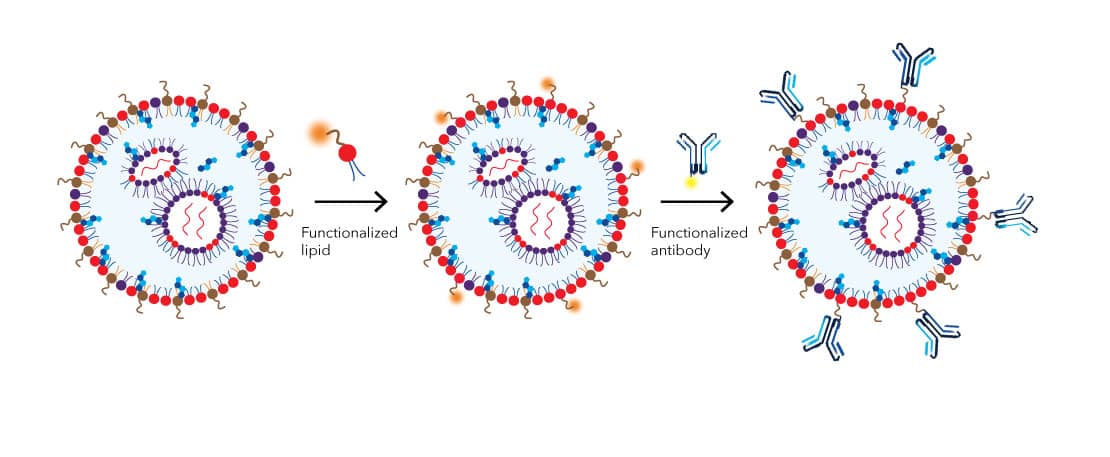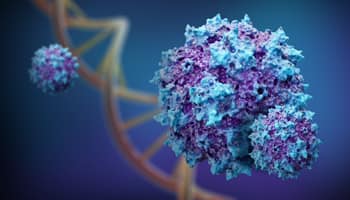What are Lipid Nanoparticles (LNPs)?
LNPs are lipid-based delivery systems used for transporting bioactive nucleic acid payloads into cells. They are less than 100 nanometers in diameter and are composed of a lipid monolayer on the outside, which encloses an inner core containing cargo molecules, such as RNA-based drugs and gene-editing tools (e.g. CRISPR-Cas9), enveloped by reverse micelles.
Many methods have been developed for the synthesis of LNPs, ranging from manual mixing with basic lab equipment for small-scale, rapid preparation, to employing microfluidic mixing devices for more reproducible large-scale production.

Lipid Nanoparticle Components
There are four essential components of LNP formulations. Ionizable lipids possess a transient cationic charge at low pH, forming inverted micelles in complex with oligonucleotide cargos, circumventing the toxicity of cationic lipids. PEG lipids are the 'stealth lipids', preventing serum protein adsorption and nanoparticle aggregation, increasing in vivo circulation time. Phospholipids and sterol lipids are the 'helper lipids' that contribute to particle structure, efficacy of membrane fusion, and provide structural integrity.
| LNP component | Product | Cat. No. |
| Ionizable lipid* | DLin-MC3-DMA | 7946 |
| Phospholipid* | DSPC | 7943 |
| PEG lipid* | DMG-PEG 2000 | 7944 |
| Sterol lipid* | Cholesterol | 7945 |
| Cationic lipid | DC-Cholesterol hydrochloride | 7176 |
| Functionalized lipid | DSPE-PEG 2000 Maleimide | 7947 |
*Essential components for LNP synthesis.
Lipid Nanoparticle Applications
LNPs are commonly used in clinically advanced non-viral gene delivery systems. They offer several advantages over viral delivery vector. LNPs possess lower cytotoxicity, diminished immunogenicity, and better transfection efficiencies.
Vaccine Development
Vaccine Development
The scalable LNP delivery systems have been employed in COVID-19 mRNA vaccine development. Many other LNP-mRNA formulations are under clinical evaluation for the prevention of viral infections.
Discover the tailored solutions you really need, from validated antibodies and immunoassays to fully automated analytical instruments.
Gene Therapy
Gene Therapy
Using LNPs for gene therapy offers several advantages over viral vectors. LNPs excel in the emerging field of genomic medicines due to their ability to provide safe and efficient in vivo delivery, addressing a key challenge in gene therapy. Additionally, LNPs overcome other limitations associated with viral vectors, such as payload size constraints and the ability to redose, making them a versatile and promising alternative for gene delivery.
Immuno-Oncology
Immuno-Oncology
LNPs allow the delivery of oligonucleotides to generate systemic anticancer immunity via cytotoxic immune cell activation, chimeric antigen receptor cell (CAR) therapies, and checkpoint blockade.
Characterize your immune cell samples with reproducible, highly sensitive analytical tools and reagents.
Future Direction of LNP Research: Tissue-Specific Delivery

Intravenously administered LNPs tend to be taken up by hepatocytes and accumulate predominantly in the liver, limiting their applications. The targeting of other cell types is therefore a pivotal area of research in nanomedicine. Incorporating a reactive chemistry handle like DSPE-PEG 2000 Maleimide onto the surface of LNPs enables the attachment of various targeting agents, such as antibodies, peptides, integrin ligands, glucose, transferrin, or folic acid. This significantly broadens the potential applications of LNPs. Preserving the functionality of the targeting agent involves a two-step process. In the first step, functionalized lipids form micelles that selectively embed into the outer membrane of the LNP, introducing reactive chemical groups (e.g., maleimide) to the LNP's surface. In the second step, the targeting agent, such as an antibody, is conjugated to the LNP's surface using these reactive groups. This methodology can be employed in the synthesis of CD4-targeted LNPs to produce CAR T cells in an in vivo setting.
-
Finn et al. (2018) A single administration of CRISPR/Cas9 lipid nanoparticles achieves robust and persistent in vivo genome editing Cell Rep. 2227:22. PMID: 29490262.
-
Loughney et al. (2019) Development of an imaged capillary isoelectric focusing method for characterizing the surface charge of mRNA lipid nanoparticle vaccines Electrophoresis 2602:18. PMID: 31218707.
-
Wilson et al. (2022) Lipid nanoparticles in the development of mRNA vaccines for COVID-19 J.Drug Deliv.Sci.Technol. 103553:74. PMID: 35783677.
-
Zhang et al. (2022) Application of lipid-based nanoparticles in cancer immunotherapy Front Immunol. 967505:13. PMID: 36003395.
-
Krebs et al. (2022) Two quality and stability indicating imaged CIEF methods for mRNA vaccines Electrophoresis 43:1971. PMID: 36004399.




